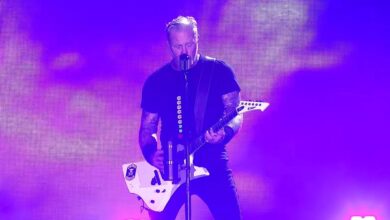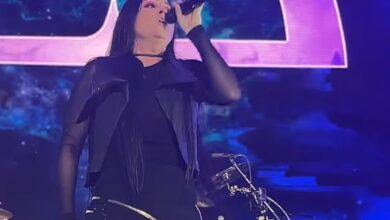When Power Meets Grace: How Disturbed and Ann Wilson Created a Rock Duet for the Ages
The night the official video for “Don’t Tell Me” arrived, it felt less like a typical Friday drop and more like a curtain lifting on a collaboration people didn’t realize they needed. Disturbed had already threaded the needle between brute strength and vulnerability on record, but pairing David Draiman’s volcanic baritone with Ann Wilson—arguably the definitive female rock voice—instantly reframed expectations. The hush in the opening measures, the weight in the lyric, the stately pacing: it all suggested a band leaning into mood, not muscle, and trusting two singular voices to carry the emotional freight. That choice alone set the tone for what made this event feel special.
To understand why the moment resonated, you have to wind back to the album that seeded it. Divisive, released on November 18, 2022, was Disturbed’s first full-length in four years, a record forged in the tinderbox of recent upheavals. Somewhere within its track list sat a ballad that needed a counter-voice—someone who could match Draiman’s intensity with lived-in gravitas. The band had never welcomed a guest vocalist on a studio track before, but on “Don’t Tell Me,” they made an exception, and not just any exception: Ann Wilson of Heart. That single decision—first-ever guest, first-ever duet of this kind—altered the album’s emotional geometry.
If the studio collaboration was a creative leap, the video premiere crystallized it. Directed by Matt Mahurin and unveiled on January 12, 2024, the piece embraced an austere, almost sepia-cinema aesthetic: close-ups that lingered, negative space that felt like a third character, and intercut vignettes of a relationship unspooling in silence. Mahurin’s camera resists spectacle, preferring texture—creases, breath, steadied hands—and the effect is a visual companion that amplifies the lyric’s ache rather than competing with it. It’s the rare rock video that moves by restraint, not velocity.
On paper, the pairing is intriguing; in practice, it’s combustible. Draiman’s delivery carries the clenched-jaw resolve of someone trying to hold a line; Wilson’s entrances arrive like a truth that can’t be deferred any longer. Their voices don’t blend so much as braid—separate strands, distinct timbres, crossing and tightening until harmony feels inevitable. When they land on a shared phrase, there’s a chiaroscuro effect: light and shadow in balance, steel softening to velvet and back again. That interplay is the performance’s beating heart and the clearest reason the clip took on a life beyond the usual release-day churn.
The origin story is tinged with mutual admiration. Years before this duet, Wilson publicly praised Disturbed’s interpretation of “The Sound of Silence,” a reading that proved the band’s appetite for cinematic dynamics as much as cathartic roar. That admiration opened a door; once Disturbed had the “Don’t Tell Me” demo in hand, their guitarist Dan Donegan floated a radical idea—bring Wilson in. She wasn’t a cameo; she was the missing perspective. The band reached out, the conversation turned real, and the studio calendar made room for a first: a guest vocalist on a Disturbed album.
What’s striking is how the song relocates Disturbed’s power center. Instead of a hook built on rhythmic assault, “Don’t Tell Me” builds on negative space—the pauses where something might have been said but wasn’t, the long look across a room that confirms what both people already know. Guitars are trimmed to a mournful glimmer and a slow-burn swell; percussion enters like a pulse you didn’t know you were following; and the lyric’s refusal—don’t say it, don’t make it real—becomes the refrain that tightens the vice. The video’s repeated cuts to faces and hands underscore that the battlefield here is intimacy, not impact.
When the single first surfaced in 2022 as part of the album roll-out, fans clocked how unusual it was for this band to invite someone from outside the hard-modern-metal universe into their core. By the time the video arrived in early 2024, the novelty had given way to a different conversation: here was a contemporary metal act expanding its expressive palette without compromising identity, and here was a classic-rock icon refusing to be typecast by her own legend. In interviews around the release, Draiman didn’t soft-pedal his admiration, calling Wilson “the greatest female rock voice of all time”—a line that played less like flattery than an accurate inventory of what the track required.
It also mattered when the video hit. Disturbed were days away from a U.S. run that leaned heavily into pyrotechnic scale, and here came a four-and-a-half-minute advertisement for the power of stillness. In some ways, the contrast sharpened both sides of the band’s identity: the arena act that can rain fire, and the ballad architects who can draw entire crowds inward. For fans planning to catch the tour, the video played like an invitation to expect dynamics—scream and whisper, ignition and ember—rather than monochrome assault.
Ann Wilson’s presence brings its own narrative weight. She’s part of a lineage of singers who can detonate a chorus, yes, but she’s equally fluent in the theatrical slow burn. On “Don’t Tell Me,” she opts for the latter, polishing lines until they glow with fatigue and clarity. Her tone—midrange warmth with a flint edge—arrives like a confession. Crucially, she doesn’t echo Draiman; she answers him. That give-and-take reframes the lyric from a monologue into a dialogue, the story of two people negotiating which truths to speak and which to leave unspoken. It’s the collaboration’s defining insight.
If Mahurin’s direction is spare, it’s not minimalist; it’s concentrated. The camera circles the faces like a vulture refusing to land, building unease not through jump cuts but through patience. There are few literal clues—no heavy-handed props, no explanatory flashbacks—just textures and glances, a motif of distance measured in inches. Where many rock videos telegraph urgency through motion, this one finds it in stillness, trusting that two singers at the height of their interpretive powers can generate plenty of heat in a cold room. For a band famous for kinetic catharsis, that trust reads as daring.
Zoom out, and the collaboration functions like a Rosetta Stone for Disturbed’s broader arc. Over the last decade, they’ve threaded acoustic shadows into electric thunder, proving that menace and melancholy aren’t opposing forces so much as neighboring weather systems. The embrace of a true duet with a rock elder stateswoman isn’t a detour; it’s a continuation of that thesis. You can hear that continuity in the way the arrangement swells without ever overwhelming the singers—how the band’s muscle supports, rather than supersedes, the human voice at the center.
There’s also a cultural subtext worth naming. Cross-generational, cross-subgenre collaborations can feel like marketing exercises if the song doesn’t justify the handshake. “Don’t Tell Me” avoids that trap by giving both artists something only the other can unlock. Draiman gets an equal who can meet pathos with poise; Wilson gets a foil who can ground her elegance in granite. The result isn’t a compromise but a third thing—a new color in both palettes. That mutual benefit is why fans of Heart and fans of Disturbed alike found themselves sharing the same link.
On social channels, the rollout doubled as a chorus of co-signs. Disturbed’s posts struck an appreciative tone; Wilson’s note, shared in the band’s feeds, framed the duet as a genuine artistic encounter, not a transaction. The language was consistent across outlets: respect, honor, gratitude, surprise—words that suggest the collaboration wasn’t merely scheduled but felt. In a period when content rarely lingers longer than a weekend, that sincerity helped the piece live beyond the news cycle.
Another reason the moment mattered: it subtly re-educated audiences about what “heavy” can mean. There’s no shortage of decibels in Disturbed’s catalog, but here, heaviness is measured in consequence, not distortion—the emotional gravity that accumulates when goodbye hovers in the doorway, when love becomes triage. That’s why the climactic harmonies hit as hard as any breakdown: not because they’re louder, but because they arrive precisely where denial collapses into acknowledgment.
By the time the final shot dissolves, the performance has accomplished a lot in not-quite five minutes: established a narrative without plot, showcased two singular instruments without showboating, and reminded a broad listenership that the most enduring rock moments aren’t always the flashiest. Sometimes they’re the ones that sit with you at the kitchen table afterward, when the phone is face-down and the room is quiet, asking: what would I have said? What would I have left unsaid?
The collaboration also nudged open doors for what comes next. Once a band breaks the seal on its “no guests” policy with a result this convincing, the audience’s imagination goes wild—who else could occupy that second mic? Yet the power of “Don’t Tell Me” suggests restraint: it works because it’s specific. Wilson isn’t a plug-and-play feature; she’s a dramatic necessity, the voice that turns the song’s thesis into a conversation. The lesson isn’t “more features”; it’s “the right feature, for the right reason.”
For Disturbed fans who came in through stadium bangers, the track offers a gateway into another wing of the house; for Heart devotees who arrived for Wilson, it’s a primer on a modern metal outfit that treats dynamics as a weapon, not a concession. The Venn diagram overlap—visible in comments, shares, and the way classic-rock outlets and metal trades alike covered the drop—speaks to a broader truth about rock in the 2020s: the best stories are happening in the gray areas between subgenres.
And so the video’s premiering weekend closed with something unusual for a rock duet in the algorithm era: momentum. Not just view counts, but that stickiness where friends text friends, “Did you see this?,” and the answer circles back days later. The craft explains part of it. The casting explains more. But the rest is harder to quantify: that sense of occasion you can’t manufacture, when two artists at different poles of the same tradition find the shared note that turns a release into an event. That’s the current “Don’t Tell Me” tapped—and why it still hums after the last frame fades to black.





